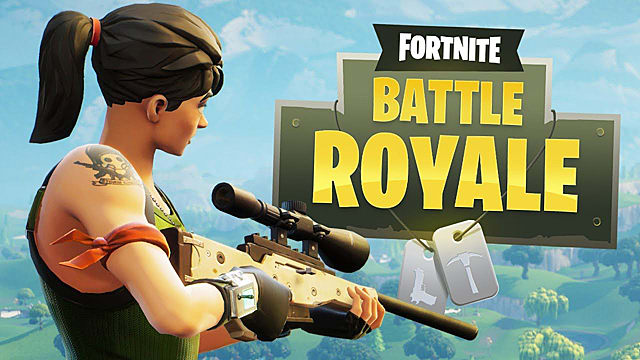Fortnite: Battle Royale Review - Laying The Foundation
For a game that was long in development as a cooperative horde-based shooter, the conspicuous and relatively quick addition of battle royale to Fortnite seemed to be a move to capitalize on a trend. However, its seemingly simple building system and loose shooting mechanics not only set it apart from other games built on the same premise, but work extremely well to make a uniquely chaotic and surprisingly deep deathmatch experience.
Everything about Fortnite's presentation emits a lighthearted tone. You start a match by jumping out of a party bus held up by balloons that flies across the game's massive map. Weapons, ammo, and health items litter its silly-named cities, all using alliteration--Tomato Town, Moisty Mire, Tilted Towers, to name a few. Even enemies don't really die; they're teleported away after getting knocked out. Valuable loot is found inside pinatas called supply llamas, for crying out loud. Players throw up basic structures formed out of thin air and firearms brightly express their trajectory. But don't let that first impression fool you; the further you get into a match, the more you see how Fortnite's gameplay elements have to be used in clever and complex ways to emerge victorious.

Unique to Fortnite is a streamlined building system comprised of four components: walls, ramps, floors, and roofs. These are constructed with three different types of materials that you either mine with a pickaxe or scavenge across the map; wood, stone, and metal each have their own properties in terms of durability and build speed. You can further modify structures to have windows and doors. It seems convoluted, but thanks to snappy grid-based layouts and the intuitive control scheme, getting the hang of building isn't much of a hurdle.
Approaches to combat also rely on the weapons you scavenge. A typical arsenal made up of rifles, submachine guns, shotguns, and pistols have colored tiers to indicate varying levels of power and rarity. Each gun has a sensible use-case, however, traps and explosives mix things up a bit. This is another aspect in which Fortnite diverges from many other battle royale games; shooting is fast and loose, akin to an arena shooter. Mid-range firefights and close-quarters combat feel more like a fatal dance in and around the structures plopped into the environment. Bunnyhopping with a tactical shotgun is common at close range and spraying assault rifles is standard operation. Fortnite isn't a tactical shooter in the traditional sense, but offers its own bevy of strategic options to keep players on their toes.


Enemy engagement still carries the risk you expect from games of this ilk by nature of having one life per match and the relatively quick time-to-kill. Even after downing a Chug Jug for full health and shield, well-placed shots from a legendary or epic weapon will make short work of anyone. However, the brisk pace at which matches move trades unnerving tension for a higher frequency of action. Yet, as with any battle royale game, looting for resources sits at the core of matches and eats up much of your time. The system in place for loot and resource gathering is efficient, but it grows tiresome after consecutive matches as swinging the pickaxe at trees and houses for necessary materials grows increasingly repetitive.
Another area in which Fortnite is a bit thin is in its map design, a shortcoming that's twofold. The sprawling lone map features a variety of cute, thematic areas: Its metropolis of Tilted Towers and suburbs of Pleasant Park contrast the swamps of Moisty Mire and the countryside of Anarchy Acres. Regardless, there's a feeling many of the map's landmarks lack sophistication in physical layouts and density in loot placement. To its credit, the map's verticality brings the best out in your construction abilities, but city centers like Tomato Town have little to work with when two squads land in the area. A slightly more intricate town like Snobby Shores is sometimes devoid of useful items. It'd be easier to overlook this if you didn't have to trek across to a nearby town on foot that's likely to have been looted, but such is the case


In just about half a year, Epic has demonstrated strong support with a consistent rollout of new content. Those who have been playing the game are aware of the limited-time modes that put a slight twist on the standard mode. Snipers-only or explosives-only matches have added a neat touch, but past modes like 50v50 or Teams of 20 do much more to change Fortnite's pace and open up new ways to play the game. If that's any indication, Fortnite could have plenty more to offer as it evolves further.
This is a free-to-play game, so you should be aware that it sustains itself through microtransactions. A $10 Battle Pass opens a slew of skins to earn and provides new goals to work towards. It's a reasonable system in that these objectives reward you with cosmetic items that visibly pop within Fortnite's bright art style. There's nothing to infringe on how the game plays, thankfully. If you wish to engage in making your pickaxe to look like a toy, don seasonal outfits, or get the latest viral dance as an emote, you either put in the time to earn it or shell out money for the game's V-Bucks.
While there are several moving parts in the game's ecosystem, Fortnite's biggest accomplishment is in how it seamlessly merges a number of simple mechanics to create a distinguishable battle royale game. What looks to be a straightforward building system steadily escalates to an elaborate display of tactical prowess. As the saying goes: It's easy to learn, hard to master. Although a few shortcomings in the map design eventually surface and fatigue in looting can set in, Fortnite rarely fails at challenging you in unexpected ways, resulting in something more than just another typical last-person-standing shooter.
Comments
Post a Comment